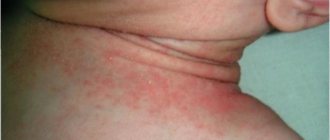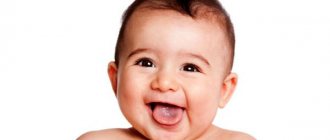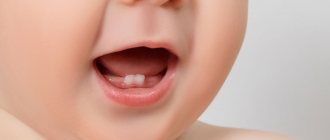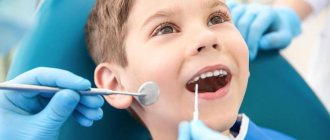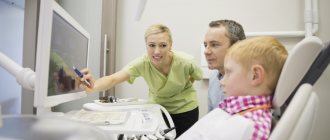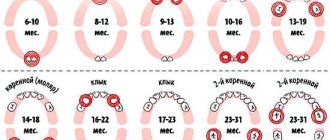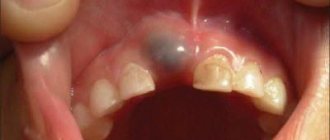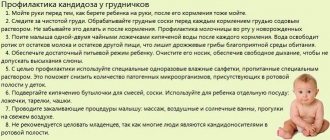Hypertrophy and inflammation of the adenoids in children often require surgical treatment, since this ENT pathology leads to painful recurrent otitis media, chronic rhinosinusitis, adenoiditis, difficulty breathing, obstructive sleep apnea (breathing stops), hearing loss, impaired speech development, malocclusion, development of the facial skeleton and the development of the “adenoid” type of face. In addition, constant disruption of nasal breathing leads to chronic hypoxia and significantly inhibits the child’s intellectual development.
Child's nose, nasal mucosa in children
The nose of a young child is relatively small, the nasal passages are narrow, and the lower nasal passage is absent. The nasal mucosa is delicate, relatively dry, and rich in blood vessels. Due to the narrowness of the nasal passages and the abundant blood supply to their mucous membrane, even minor inflammation causes difficulty breathing through the nose in young children. Breathing through the mouth is impossible in children in the first six months of life, since the large tongue pushes back the epiglottis. The exit from the nose, the choanae, is especially narrow in young children, which is often the cause of long-term disruption of nasal breathing in them.
Paranasal sinuses in children
The paranasal sinuses in young children are very poorly developed or completely absent. As the facial bones (upper jaw) increase in size and teeth erupt, the length and width of the nasal passages and the volume of the paranasal sinuses increase. By the age of 2 years, the frontal sinus appears, and the maxillary cavity increases in volume. By the age of 4, the lower nasal passage appears. These features explain the rarity of diseases such as sinusitis, frontal sinusitis, ethmoiditis in early childhood. Consultations with a pediatric ENT specialist at the Markushka clinic.
In young children, the inhaled air is poorly warmed
Due to the insufficient development of cavernous tissue in young children, the inhaled air is poorly warmed up; therefore, children should not be taken outside at temperatures below -10 degrees. C. Cavernous tissue develops well by the age of 8-9 years, this explains the relative rarity of nosebleeds in children of the 1st year of life. A wide nasolacrimal duct with underdeveloped valves contributes to the transfer of inflammation from the nose to the mucous membrane of the eyes (examination by a pediatric ophthalmologist at the Markushka clinic). Passing through the nose, atmospheric air is warmed, moistened and purified. Every 10 minutes, a new layer of mucus passes through the nasopharynx, which contains bactericidal substances (lysozyme, complement, etc.), secretory immunoglobulin A.
Advantages of pediatric ENT surgeries at the Pirogov Clinic
All the best for children! In our clinic, pediatric ENT surgeries using modern endoscopic technology are performed by Dr. Vyacheslav Valerievich Vavin, whose contribution to the development of domestic healthcare and medicine, as well as unique operations to restore breathing, hearing and the health of the ENT organs, have been repeatedly awarded by prestigious awards from Russian and European institutions . Together with colleagues from Italy, in 2022, the doctor successfully performed a unique reconstructive operation to restore the epiglottis and tongue of a 5-year-old boy Anton from the Kemerovo region. This event was covered in major federal and regional media. In addition, the doctor is a candidate of medical sciences and the author of more than 10 patents for the treatment of diseases of the ear, nose and throat.
In addition to professional assistance from high-class specialists, we offer our patients:
- Discounts, special offers and promotions for treatment by ENT doctors.
- Our own laboratory - you receive accurate examination results without queues and quickly, and if necessary, we send them by e-mail.
- Medical offices and operating rooms equipped with the latest technology from trusted brands.
- Availability of a day hospital and high-comfort wards.
- Availability of all highly specialized doctors and medical specialists in one place.
Make an appointment
Tonsils, adenoids in a child, children
By the age of 4-10 years, the tonsils are already well developed, and their hypertrophy can easily occur. During puberty, the tonsils begin to undergo reverse development.
The tonsils are like a filter for microbes, but with frequent inflammatory processes, a focus of chronic infection can form in them, causing general intoxication and sensitization of the body.
The proliferation of adenoids (nasopharyngeal tonsil) is most pronounced in children with constitutional abnormalities, in particular with lymphatic-hypoplastic diathesis. If the adenoids are significantly enlarged (degree 1.5-2), they are removed, since nasal breathing is impaired in children (children breathe with an open mouth - the air is not purified and warmed through the nose, and therefore they often suffer from colds), the shape of the face changes (adenoid face), children become distracted (mouth breathing distracts attention), and their academic performance deteriorates. When breathing through the mouth, posture is also disturbed; adenoids contribute to the formation of malocclusion. Treatment of adenoids - homeopathic pediatrician, Markushka clinic.
Tonsillotomy as a method of treating hypertrophy of the palatine tonsils
Far from being the rarest diagnosis in children is hypertrophy of the palatine tonsils. Enlarged tonsils cause one or more problems at once:
- difficulty breathing through the nose
- sleep apnea
- snore
- shortness of breath, shallow breathing
- a sore throat
- speech disorders
- headache
- disturbances in concentration, work ability
Causes of enlarged tonsils
Doctors believe that the sharp growth of cells in the tissues that make up the tonsils is associated with the body's immune response. At an early age, a person is more susceptible to infectious diseases than as an adult. Tonsils, as one of the barriers to infection in the body, are under attack from diseases that can provoke hyperplasia - unusually rapid growth of cells in tissues without signs of inflammation.
How to determine that a child has enlarged tonsils?
Firstly, you need to visit an ENT doctor at least once a year. Upon examination, he will be able to clearly establish the pathology.
Secondly, if a child breathes predominantly through the mouth, this is an alarming symptom; nasal breathing may already be impaired.
Third, pay attention to your child's sleep. Snoring or sudden stops in breathing (apnea) are also evidence of enlarged tonsils.
How to treat hypertrophy of the palatine tonsils?
Often patients do not want to take action if tonsil enlargement does not interfere and does not affect the quality of life. However, it is necessary to treat problems in the throat - there are other organs located near the palatines to which hyperplasia can spread. Often the process involves the pharyngeal tonsils.
There are three types of treatment methods for tonsil hypertrophy: physiotherapy of the throat, surgery and the use of medications.
Physiotherapy of the throat and its organs:
- UHF;
- ozone therapy;
- mud therapy;
- ultrasonic massage.
Drug treatment for enlarged tonsils consists of a combination or isolated use of immunostimulating drugs, corticosteroids, and antibiotics. A solution of silver nitrate is also often prescribed. The drug treatment strategy is determined only by the doctor; you cannot use the drugs yourself.
Operation tonsillotomy
While monitoring the development of tonsil hypertrophy, the doctor may suggest their removal - tonsillotomy. This is a fairly common procedure and the risk of undergoing it is minimal, especially considering the possible consequences of refusing treatment.
With tonsillotomy (as opposed to tonsillectomy), the tonsil is not completely removed, but only the affected part is affected. At the same time, in the future, the tonsils will recover and will be able to continue to perform their function.
This operation is not one of the most complex, but it is performed only by the operating ENT doctor. In Voronezh you can apply for this. Our operation is performed using laser surgery. Laser tonsillotomy does not require general anesthesia; local anesthesia is used.
This operation belongs to the so-called “one-day operations” - after the procedure, the patient does not remain in the hospital, but can safely spend the night at home. The ENT doctor operating on the patient schedules a follow-up appointment in a week to ensure proper regeneration of the mucous membrane.
Contraindications to tonsillotomy surgery
The operation is not performed if:
- The child was diagnosed with diphtheria bacilli
- An infectious disease occurs in an acute form
- History of blood disease
Do I need to remove my tonsils completely?
It is possible, but not recommended unless absolutely necessary. The tonsils still act as a kind of barrier to infections that seek to penetrate the lungs, bronchi or trachea. After partial removal, the organ is regenerated and its functions are restored. Tonsillectomy does not leave the body the opportunity to restore the tonsils - complete and final removal occurs.
You can make an appointment with an ENT doctor by phone +7 or through an online appointment on the website
Larynx in children
The larynx in young children has a funnel-shaped shape (later - cylindrical) and is located slightly higher than in adults (at the level of the 4th cervical vertebra in a child and the 6th cervical vertebra in an adult). The larynx is relatively longer and narrower than in adults; its cartilages are very pliable. The false vocal cords and mucous membrane are delicate, rich in blood and lymphatic vessels, elastic tissue is poorly developed. The glottis in children is narrow. Young children's vocal cords are shorter than older children's, which is why they have a high-pitched voice. From the age of 12, boys' vocal cords become longer than girls'. These features of the larynx explain the easy development of stenotic phenomena in children, even with moderate inflammatory changes in the mucous membrane of the larynx.
The increased neuromuscular excitability of a small child is also of great importance. Hoarseness, often observed in young children after a cry, often depends not on inflammatory phenomena, but on the weakness of the easily fatigued muscles of the vocal cords.
Treatment of sore throat in children
Prices from 2,000 rub. for consultation.
Sore throat is an inflammation of the tonsils of an infectious-allergic nature, which is especially severe in children. A common causative agent of the disease is streptococcus. The bacterium protects itself from the immune system by melting the tissue adjacent to the site of inflammation. The lymph nodes surrounding the throat cannot resist the attack of the pathogen, as a result the body launches active production of antibodies that can stop the bacterial spread.
Bacterial sore throat recedes, but there are so many antibodies that they begin to fight the cells of the child’s body, primarily the joints and heart. Therefore, treatment of angina in children should be carried out under the supervision of a qualified doctor. In every tenth child, tonsillitis is caused by Staphylococcus aureus, less often chlamydia, pneumococcus, fungi or Haemophilus influenzae. Viruses most often affect children under 3 years of age.
Types of sore throat
Depending on the causes, tonsillitis occurs in a primary, secondary or specific form. Primary tonsillitis is immediately localized in the tonsil area, and secondary tonsillitis occurs against the background of an existing pathology such as measles, scarlet fever, etc. The specific form of the disease develops against the background of infection by pathogenic bacteria such as chlamydia, candida etc.
Depending on the form of damage to the tonsils, the following types of tonsillitis are distinguished:
| A type of acute sore throat | Features of the lesion |
| Follicular |
|
| Catarrhal |
|
| Purulent |
|
| Lacunarnaya |
|
| Herpes (viral sore throat) |
|
Viral tonsillitis is more common in children aged 1-2 years. Acute sore throat can often recur. Then the disease is detected in the child more often 3-4 times a year. Chronic tonsillitis, unlike the acute form, is characterized by a long course of up to 3 months.
Symptoms of sore throat in children
If a child has symptoms indicating the development of tonsillitis, home treatment is unacceptable. You should immediately contact an ENT doctor if you notice the following signs:
- sore throat, worsens when swallowing;
- sudden temperature up to 39°C;
- severe congestion;
- painful aches in joints and muscles;
- state of weakness, fatigue;
- causeless headaches;
- cervical and submandibular lymph nodes are enlarged;
- tonsils swollen, throat red;
- there is a white, sometimes gray coating on the tongue.
Sometimes tonsillitis occurs without fever, which is often associated with the absence or very weak immunity of the child. General symptoms of sore throat in children are often accompanied by:
- gastrointestinal disorders - vomiting, loose stools, nausea;
- aversion to food;
- hoarseness of voice;
- anxiety, capricious behavior of the child, sleep disturbances.
The symptoms of different types of tonsillitis overlap, so to develop the right treatment tactics you need to get tested. You should not engage in self-diagnosis and treatment, especially in children under one year old. Sore throat is dangerous due to complications, so at the first symptoms you need to call a doctor.
Why is tonsillitis dangerous in children?
If the patient consults an ENT specialist in a timely manner and receives adequate treatment, the sore throat will go away without consequences.
With incorrect or delayed therapy, dangerous complications develop:
- laryngitis,
- lymphadenitis,
- pharyngitis,
- acute otitis media,
- sepsis due to infection entering the bloodstream,
- infection of the mediastinal organs.
Viral tonsillitis in children can be complicated by a bacterial infection of the nose, as indicated by the appearance of green discharge, and bacterial tonsillitis develops. Frequent complications also include lesions of the oropharynx by fungal microorganisms and exacerbations of chronic pathologies.
The course of the disease in children under 6 years of age is associated with risks of complications and is more severe than, for example, in patients 11 years of age. Any form of tonsillitis can trigger pathological processes in the nervous and cardiovascular systems, bones and genitourinary organs.
Therefore, after treating a sore throat in children, it is recommended to do an ECG and be sure to repeat it after 6 months, conduct laboratory diagnostics, including a general urine test, and also be sure to repeat the analysis after six months, exclude vaccination for a month. Alarming symptoms after treatment of tonsillitis - the appearance of swelling of the extremities, shortness of breath, pain in the joints and chest.
Causes of sore throat in children
In children under 5, lettonsillitis most often develops due to viral activity. Pathogens include adenoviruses, influenza or herpes, enteroviruses, rhinoviruses, etc. Streptococci are also often triggered by streptococci. The disease is highly contagious. Infection easily occurs by sneezing, talking, through toys or dishes. Pathogens settle on the surface of the tonsils. After infection, a sick child continues to spread the infection for another month.
The risk of infection in children increases many times under the influence of factors:
- cold weather;
- hypothermia (ate ice cream, got wet in the rain);
- poor nutrition;
- parents smoking in the presence of the child;
- neglect of personal hygiene;
- weakened general or local immunity;
- inflammatory foci in other organs;
- changes in climatic conditions;
- carious lesions;
- chronic infections;
- frequent stress;
- previous acute respiratory viral infections, influenza and other viral infections;
- diabetes, tuberculosis and other diseases;
- allergic reactions;
- contact with an infected person, etc.
Modern children lead a sedentary life, eat fast food, and rarely go out of town. As a result, after the slightest hypothermia, pathogens begin to develop in the throat, even after ice cream or cold lemonade. Viral sore throats caused by adenovirus or influenza usually occur during cold seasons, especially during epidemics. Herpetic infection, on the contrary, is more often diagnosed in the summer.
Methods for diagnosing angina
At the first appearance of signs of tonsillitis, you should contact an ENT doctor or pediatrician. The doctor will examine the tonsils, collect anamnesis, and find out details regarding the child’s general well-being. You can use our high-precision diagnostic equipment and many years of experience as ENT specialists and get tested in our medical center:
- A blood test will determine the nature of the sore throat (bacterial or infectious), and helps assess the degree of the immune response to the pathology.
- Bakposev - accurately identifies the causative agent of tonsillitis. A biosample is scraped from the back of the child's throat with a cotton swab.
If necessary, our specialists will perform pharyngoscopy, which allows us to determine the degree of redness and infiltration of the tonsils, and assess the intensity and nature of plaque. Such highly accurate diagnostics allows our ENT specialists to accurately determine the form of tonsillitis and prescribe effective therapy.
Treatment methods for sore throat in children
Most often, children under 10 years old suffer from tonsillitis. Typically, therapy is carried out at home, but only under supervision and on the recommendation of a doctor. Only severe forms of the disease require hospitalization and inpatient treatment:
- tonsillitis with complications,
- diphtheria,
- concomitant pathologies such as kidney failure or diabetes,
- difficult general clinic,
- lack of positive dynamics a week after the start of treatment,
- severe intoxication.
Clinical recommendations for the treatment of tonsillitis are based on medication, bed rest and a gentle diet. In the first days of illness, the child needs rest and bed rest. It is better to isolate the little patient for a while to prevent the infection from spreading to the rest of the household.
It is important to stick to a diet and feed your child light soups, purees or cereals. During illness, you need to avoid hot, spicy and solid foods. Give the patient more warm drinks and ventilate his room more often. Traditional methods such as compresses and thermal procedures are strictly prohibited, as they can cause severe swelling of the throat and increase the spread of infection throughout the body.
Drug treatment of angina in children is based on taking the following drugs:
- antiviral agents (only as prescribed by a doctor): Grippferon, Ergoferon, Kagocel, etc.;
- antipyretics if hyperthermia exceeds 38°C;
- Regidron – prevents dehydration;
- antihistamines – Suprastin, Zodak;
- if a bacterial infection occurs or tonsillitis is caused by bacterial activity, antibiotics are prescribed; in other cases, therapy is carried out without antibiotics, which only weaken the immune system, aggravate the course of the disease and reduce the effectiveness of antiviral drugs;
- to reduce sore throat, doctors recommend using antiseptics in the form of sprays (Hexoral, Tantum Verde), absorbable tablets (Lizobakt, Faringosept), rinsing with Miramistin;
- inhalation;
- Folk remedies such as gargling with a decoction of chamomile or sage effectively relieve a sore throat.
Additionally, our doctors can prescribe physiotherapeutic treatment, which is carried out in the center.
Ultrasonic irrigation of the tonsils and mucous membranes of the pharynx with medicinal solutions, vibro-acoustic treatment and laser therapy, and quartzing of the tonsils are effective. You should absolutely not give your child antibiotics on your own - they can cause serious harm to health. Antibiotic therapy is carried out only as prescribed by a doctor, and the course must be completed, even if the child’s condition has noticeably improved.The comprehensive approach of our specialists ensures rapid recovery of young patients without complications. Therefore, it is so important to consult a doctor in a timely manner to receive competent therapy.
Prevention of tonsillitis
If a sore throat bothers a child 3-4 times a year, this indicates a chronic inflammatory process. In such a case, it is necessary to urgently contact a specialist to prevent exacerbations.
Self-medication or improper therapy is fraught with more dangerous complications that can appear even 4 years after the illness or more:
- arthritis,
- heart pathologies such as insufficiency or defects,
- vasculitis,
- encephalitis,
- pyelonephritis, etc.
Competent prevention will help you avoid the disease and its serious consequences:
- maintaining personal hygiene,
- balanced diet,
- maintaining dental and oral health,
- timely treatment of infections,
- strengthening immune defense.
When the first symptoms of a sore throat appear, you need to show the child to an ENT specialist or call a pediatrician at home. If the child is under the constant supervision of a doctor according to the attachment program of our clinic, complications and severe course of the disease are much easier to avoid.
Benefits of treating sore throat in children in
Tonsillitis is a dangerous disease that requires urgent treatment. Weakened immunity, coupled with delayed therapy, can cause serious complications in the child’s cardiovascular and nervous system, bone tissue and genitourinary organs. When the first signs of a sore throat appear, contact your doctor. Our specialists have many years of practical experience and high qualifications.
Call a pediatric ENT specialist or pediatrician to your home in our clinic. The doctor will examine the patient, advise parents on treatment issues, prescribe the necessary medications, and, if necessary, invite you to the center to diagnose the form of the disease.
You can make an appointment with a pediatric otolaryngologist in our clinic by filling out a special form on the website. Our doctors have an expert level, and their experience in treating cases of childhood sore throat numbers in the hundreds. You can get advice on the treatment and recovery of a child after tonsillitis via online chat. Our doctors will also give the necessary recommendations via telegram chat.
Trachea in a child, children
The trachea in newborns is funnel-shaped, its lumen is narrow, the posterior wall has a wider fibrous part, the walls are more pliable, the cartilage is soft and easily compressed. Its mucous membrane is delicate, rich in blood vessels and dry due to insufficient development of the mucous glands, elastic tissue is poorly developed. The secretion of the glands provides a layer of mucus on the surface of the trachea 5 microns thick, the speed of which is 10-15 mm/min (provided by cilia). The growth of the trachea occurs in parallel with the growth of the body, most intensively in the 1st year of life and during puberty. The structural features of the trachea in children lead to the easy occurrence of stenotic phenomena during inflammatory processes; frequent isolated lesions (tracheitis), combined with damage to the larynx (laryngotracheitis) or bronchi (tracheobronchitis) are determined. In addition, due to the mobility of the trachea, its displacement may occur during a unilateral process (exudate, tumor).
Bronchi in a child, children
The bronchi are quite well formed at birth. The growth of the bronchi is intense in the 1st year of life and during puberty. Their mucous membrane is richly vascularized, covered with a layer of mucus, which moves at a speed of 3-10 mm/min, in the bronchioles it is slower - 2-3 mm/min. The right bronchus is like a continuation of the trachea; it is shorter and wider than the left. This explains the frequent entry of a foreign body into the right main bronchus. The bronchi are narrow, their cartilage is soft. Muscle and elastic fibers in children of the 1st year of life are not yet sufficiently developed. The tenderness of the bronchial mucosa and the narrowness of their lumen explain the frequent occurrence of bronchiolitis with complete or partial obstruction syndrome in young children.
Lungs in children, child
The lungs of newborns weigh about 50 g by 6 months. their mass doubles, triples by the age of 12, increases 10 times by the age of 12, and 20 times by the age of 20. The pulmonary fissures are poorly expressed.
In newborns, the lung tissue is less airy, with abundant development of blood vessels and connective tissue in the septa of the acini and an insufficient amount of elastic tissue. The latter circumstance explains the relatively easy occurrence of emphysema in various pulmonary diseases.
Symptoms of inflammation of the tonsils
Inflammation of the tonsils is accompanied by the following symptoms:
- Sore throat that gets worse when swallowing;
- Inflammation of the tonsils is observed on one or both sides - they become swollen and change color to dark crimson, white plaque and ulcers may appear;
- Body temperature rises. However, it is not always high and can only be observed in the evening;
- The person experiences weakness and headache, similar to the usual pain associated with colds;
- In advanced cases, a skin rash or exacerbation of other chronic diseases may appear;
- In the absence of timely treatment, inflammation of the tonsils provokes disruptions in the functioning of the heart and kidneys.
The formation of the lung structure in children depends on the development of the bronchi
The formation of the lung structure occurs depending on the development of the bronchi. After the trachea divides into the right and left main bronchi, each of them is divided into lobar bronchi, which approach each lobe of the lung. Then the lobar bronchi are divided into segmental bronchi. Each segment has independent ventilation, a terminal artery and intersegmental septa made of elastic connective tissue.
The segmental structure of the lungs is already well expressed in newborns. There are 10 segments in the right lung, 9 in the left. The upper left and right lobes are divided into three segments - 1, 2 and 3rd, the middle right lobe - into two segments - 4th and 5th. In the left lung, the middle lobe corresponds to the lingular lobe, which also consists of two segments - the 4th and 5th. The lower lobe of the right lung is divided into five segments - 6, 7, 8, 9 and 10th, and the left lung - into four segments - 6, 8, 9 and 10th. In children, the pneumonic process is most often localized in certain segments (6, 2, 10, 4, 5), which is associated with the characteristics of aeration, the drainage function of the bronchi, the evacuation of secretions from them and possible infection.
External respiration , that is, the exchange of gases between atmospheric air and the blood of the capillaries of the lungs, is carried out through simple diffusion of gases through the alveolar-capillary membrane due to the difference in the partial pressure of oxygen in the inspired air and venous blood flowing through the pulmonary artery into the lungs from the right ventricle. Compared to adults, young children have pronounced differences in external respiration due to the development of acini, numerous anastomoses between the bronchial and pulmonary arteries, and capillaries.
Should a child's adenoids (tongs) be removed?
Contrary to the widespread stereotype about the “harm” of this operation, it should be noted that the adenoids perform a protective function and are an immune organ, therefore it is important to perform modern gentle interventions using endoscopic techniques, which allows you to remove only the affected - hyperplastic area of adenoid tissue, preserving the immune structures themselves. Adenotomy is performed for medical reasons if conservative therapy does not produce good results. In an advanced stage, inflamed adenoids distort the ventilation of the nasal cavity, sinuses and middle ear. They pose a threat of serious complications that can lead to disability of the child (persistent hearing loss, chronic otitis media, chronic sinusitis), disruption of the development of occlusion and appearance.
Only an experienced doctor will be able to make a decision regarding the advisability of removing the affected adenoids in each specific case. Our clinic uses the most accurate endoscopic methods for examining the nasopharynx and ear.
Depth of breathing in children
The depth of breathing in children is much less than in adults. This is explained by the small mass of the lungs and the structural features of the chest. The chest in children of the 1st year of life seems to be in a state of inhalation due to the fact that its anteroposterior size is approximately equal to the lateral size, the ribs extend from the spine almost at a right angle. This determines the diaphragmatic nature of breathing at this age. A full stomach and bloated intestines limit the mobility of the chest. With age, it gradually moves from the inspiratory position to the normal one, which is a prerequisite for the development of thoracic breathing.
How adenoids are removed for children at the clinic named after. N.I. Pirogov?
Endoscopic adenotomy
— the most delicate surgical manipulation, which is carried out under medicated sleep conditions. It is performed under the control of special equipment and a high-resolution video system. Lymphadenoid tissue is removed gently and carefully exactly where it is needed, preserving structures important for the child’s normal immunity. Since the adenoid removal procedure is performed without trauma, the risk of complications and recovery period are minimized. As a rule, within a few hours after the operation, we discharge children from the clinic to home. The postoperative period is painless. It is important to remember that after surgery you should avoid physical activity for a while and avoid overheating. After endoscopic adenotomy, the period of such restrictions is only 7-10 days.
How are adenoids removed in children? Video on our YouTube channel
Oxygen requirements in children are significantly higher than in adults
The oxygen requirement in children is much higher than in adults. Thus, in children of the 1st year of life, the need for oxygen per 1 kg of body weight is about 8 ml/min, in adults - 4.5 ml/min. The shallow nature of breathing in children is compensated by a high breathing frequency (in a newborn - 40-60 breaths per 1 minute, at the age of 1 year - 30-35, 5 years - 25, 10 years - 20, in adults - 16-18 breaths per 1 min.), with the participation of most of the lungs in breathing. Due to the higher frequency, the minute volume of breathing per 1 kg of body weight is twice as high in young children as in adults. The vital capacity of the lungs, that is, the amount of air (in milliliters) maximally exhaled after maximal inhalation, is significantly lower in children compared to adults.
Thus, the anatomical and functional features of the respiratory system in children create the preconditions for milder breathing disorders than in adults.
